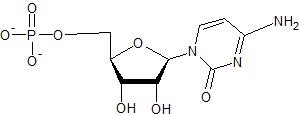17: Nucleic Acids: DNA and RNA
- Page ID
- 43931
Nucleotides and Nucleic Acids
(01) Examine these two monosaccharides and answer the following questions.

- Which monosaccharide is found in DNA, and which is found in RNA?
- Circle the key difference that distinguishes between the two monosaccharides.
- Use arrows to point to the areas where other groups bond to make them into nucleotides.
(02) Study the anatomy of this nucleotide to answer the following.

- Box the nitrogenous base. Which base is being used in this nucleotide?
- Circle the monosaccharide. Which monosaccharide is it? Is it found in DNA or RNA?
- Put a triangle around the phosphate group.
- Put a star next to carbon 5 in the monosaccharide.
- Point an arrow at the anomeric carbon.
(03) Using the following directions, sketch the nucleotide being described: Uses a monosaccharide present in RNA, and a nitrogenous base found only in RNA. Point an arow to the glycosidic bond.
(04) The linking of two nucleotides into a dinucleotide involves bonding at which site? What type of bond is this?
(05) Adding even one more nucleotide to a chain can increase the number of possible sequences exponentially. How many different possible octonucleotide (a chain of 8 nucleotides) combinations are possible?
(06) Given the nucleotide ‘puzzle pieces’ below, construct the nucleotide they will form when connected. Is this nucleotide found in DNA or RNA? Identify the monosaccharide and nitrogenous base to support your answer.

DNA
(07) What shape does DNA take in three dimensions? What intermolecular forces enable it to hold together in this shape?
(08) Each DNA strand will have a complementary strand. What is the sequence that complements the strand dGCTAGATC? How many H-bonds allow this structure to maintain its integrity and shape?
(09) Demonstrate your understanding of DNA sequences by determining the correct complementary sequence for each one shown below.
- dCAGCATA
- dTCAGTTCG
- dGGTCACGT
(10) What is a chromosome? How many of these are located inside human cells?
(11) Describe the major steps in DNA replication. What enzymes are used to catalyze these steps?
(12) How do the bases from a parent and daughter strand of DNA interact?
(13) How accurate is DNA polymerase in proofreading sequences? What does it do when a mistake is discovered?
(14) Examine the following parent and daughter DNA strands for mistakes. Rewrite the sequences as needed to correct the errors.
- dCGGTATGCA (parent) dGCTAGACGT (daughter)
- dATGCCTGAC (parent) dTAAGGTTGG (daughter)
- dTATGCCAGA (parent) dGTACGTTCT (daughter)
RNA and Protein Synthesis
(15) List the three types of RNA and their functions.
(16) For the following questions regarding RNA, tell whether they are true or false.
- RNA is double-stranded
- RNA contains 2-deoxy-D-Ribose
- RNA contains uracil in place of thymine
- RNA never leaves the nucleus
(17) Summarize, in your own words, the transcription and translation.
(18) What function does RNA polymerase serve? In what steps is it involved?
(19) For each DNA sequence, write the corresponding mRNA sequences.
- GCACGTCAC
- TTGCAAGTG
- GAGTCCATC
- TCCGTTCAA
- CGACCGATT
(20) What shape does tRNA take? What portions of this shape are significant for its ability to perform its function?
(21) For each anticodon, determine which amino acid will be delivered by tRNA?
- GAC
- ACG
- GUG
- UCA
- AGG
(22) What are the sequences for the stop codons, and how many are there?
(23) Threonine has numerous codons that correspond to it; find all sequences connected to it. What is the advantage of multiple codons for a single amino acid?
(24) Translate the following DNA sequences into their respective mRNA sequences, and determine the amino acid sequence this would generate.
- dAGGCTGCAT
- dGCCTATAAC
- dCAGTTACCG
- dATGGATTAC
- dGCTCCGTCA
(25) It is possible for a single mutation in the sequence to cause significant differences. For the given DNA sequence and its corresponding mRNA sequence, perform each indicated substitution and determine whether this one change will lead to a different dipeptide formation: dCGTTAA GCAAUU
- The leftmost nucleotide of DNA is replaced with a T
- One of the two T’s from DNA is replaced with a G (optional: try each)
- The second-from-the-right nucleotide from DNA is replaced by a C
(26) Radiation can be very damaging to the human body. Explain how ionizing radiation may cause genetic mutations in human and animal DNA, and may cause some forms of cancer.

